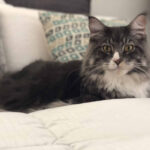Gray cats, often referred to as blue cats in feline fancy, possess a unique allure. Their coats, ranging from soft silver to deep charcoal, exude sophistication and mystery. But beyond their stunning appearance, Grey Cat Breeds offer a diverse array of personalities and traits, making them wonderful companions for various lifestyles. If you’re captivated by the charm of grey felines, explore these top 10 grey cat breeds to find the perfect silvery addition to your family.
Russian Blue: The Elegant and Intelligent Grey Cat
The Russian Blue is renowned for its striking emerald green eyes that sharply contrast with its plush, silvery blue-grey coat. Originating from Russia, likely from the Archangel Isles, this breed carries an air of aristocracy and intelligence. Their dense, double coat is not only beautiful but also hypoallergenic, making them a good choice for allergy sufferers.
 Russian Blue Cat
Russian Blue Cat
Credits: Katharina Gloth / Unsplash – Close-up portrait of a Russian Blue cat with vibrant green eyes, showcasing its plush grey coat.
Personality and Temperament: Russian Blues are known for their gentle and reserved nature. They are deeply loyal and tend to bond strongly with one or two people in the household, often following their favorite humans around. While affectionate with their family, they can be initially shy around strangers. Their intelligence shines through in their playful nature; they enjoy interactive toys and puzzles that challenge their minds. Despite their independent streak, they crave attention from their loved ones and appreciate quiet, predictable environments.
Care and Grooming: The Russian Blue’s dense coat requires weekly brushing to remove loose hair and keep it looking its best. They are relatively low-maintenance in terms of grooming and are naturally clean cats. A balanced diet and regular playtime will keep them healthy and happy.
Health Considerations: Russian Blues are generally a healthy breed with few genetic predispositions. Maintaining a healthy weight is important as they can be prone to overeating if given the opportunity.
British Shorthair: The Classic Grey Teddy Bear Cat
The British Shorthair, with its round face, copper eyes (though they can vary), and dense, plush coat, perfectly embodies the charm of a teddy bear. This breed is one of the oldest English cat breeds, believed to have been brought to Britain by the Romans. The most iconic color is the blue-grey, often referred to as “British Blue,” which enhances their dignified and calm presence.
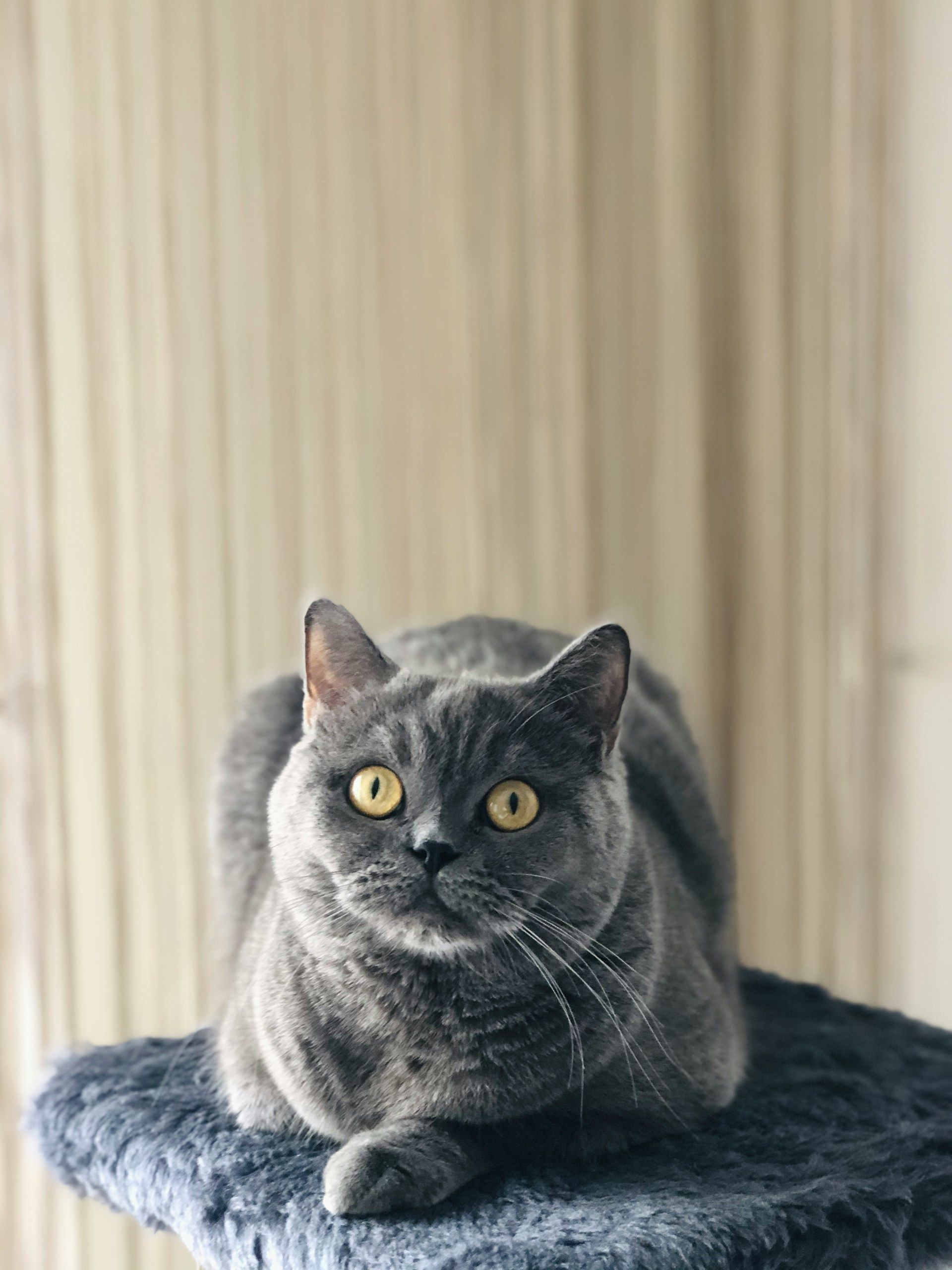 British Shorthair Cat
British Shorthair Cat
Credits: Eylül Naz DoÄŸan / Unsplash – British Shorthair cat with a round face and dense grey fur, sitting and looking directly at the camera.
Personality and Temperament: British Shorthairs are known for their easy-going and adaptable nature, making them excellent family pets. They are calm, affectionate, and not overly demanding, enjoying attention but also content with their own company. They are known to be good with children and other pets, fitting well into busy households. While playful, they are not excessively energetic, preferring gentle games and cuddles.
Care and Grooming: Their thick, dense coat requires regular grooming, especially during shedding seasons, to prevent matting and hairballs. Weekly brushing is usually sufficient, but more frequent brushing may be needed during spring and fall. They are relatively low-maintenance in other aspects of care.
Health Considerations: British Shorthairs are generally a robust breed, but they can be prone to certain health issues, including hypertrophic cardiomyopathy (HCM) and polycystic kidney disease (PKD). Responsible breeders screen for these conditions. It’s also crucial to monitor their diet to prevent obesity, as they can become less active as they age.
Chartreux: The Smiling Grey Cat of France
The Chartreux, often called “the smiling cat of France,” is a rare and captivating breed with a rich history possibly linked to Carthusian monasteries in France. Their most distinguishing features are their striking gold or copper eyes, a naturally “smiling” facial expression due to their muzzle structure, and a unique water-repellent double coat in a blue-grey shade. Their robust, muscular build adds to their distinctive appearance.
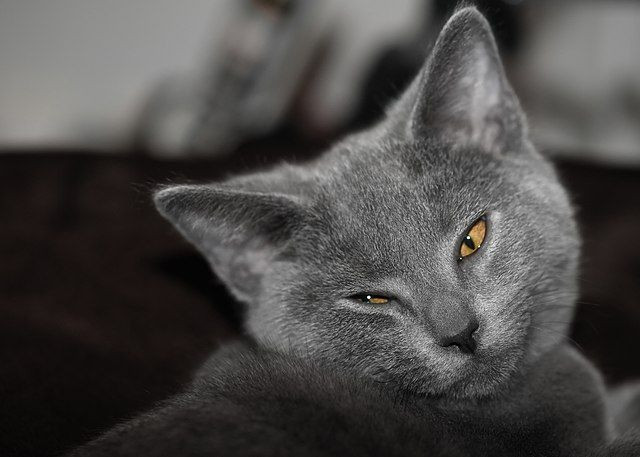 Chartreux Cat
Chartreux Cat
Credits: Stephanemartin / Creative Commons Attribution-Share Alike 3.0 – A Chartreux cat with a distinctive grey coat and orange eyes, captured in a relaxed pose.
Personality and Temperament: Chartreux cats are known for their quiet and gentle demeanor. They are less vocal than many other breeds, making them ideal companions for those seeking a peaceful home environment. Despite their calm nature, they are intelligent and playful, enjoying interactive toys and puzzle feeders. They are deeply devoted to their families and often follow their owners around the house, offering silent companionship.
Care and Grooming: The Chartreux’s dense, woolly coat requires regular grooming to prevent matting and remove loose hair. Weekly brushing is recommended, and more frequent brushing during shedding season. They are otherwise relatively easy to care for.
Health Considerations: Chartreux are generally a healthy and hardy breed. However, like all breeds, they can be susceptible to certain health issues. Patellar luxation and hip dysplasia have been reported in the breed, although they are not overly common.
Korat: The Silver-Blue Good Luck Cat from Thailand
The Korat is a naturally occurring breed from Thailand, considered a symbol of good fortune and prosperity in its native land. They are prized for their stunning silver-blue coat with tips that create a shimmering halo effect. Their heart-shaped face and large, luminous green eyes contribute to their captivating and mystical appearance.
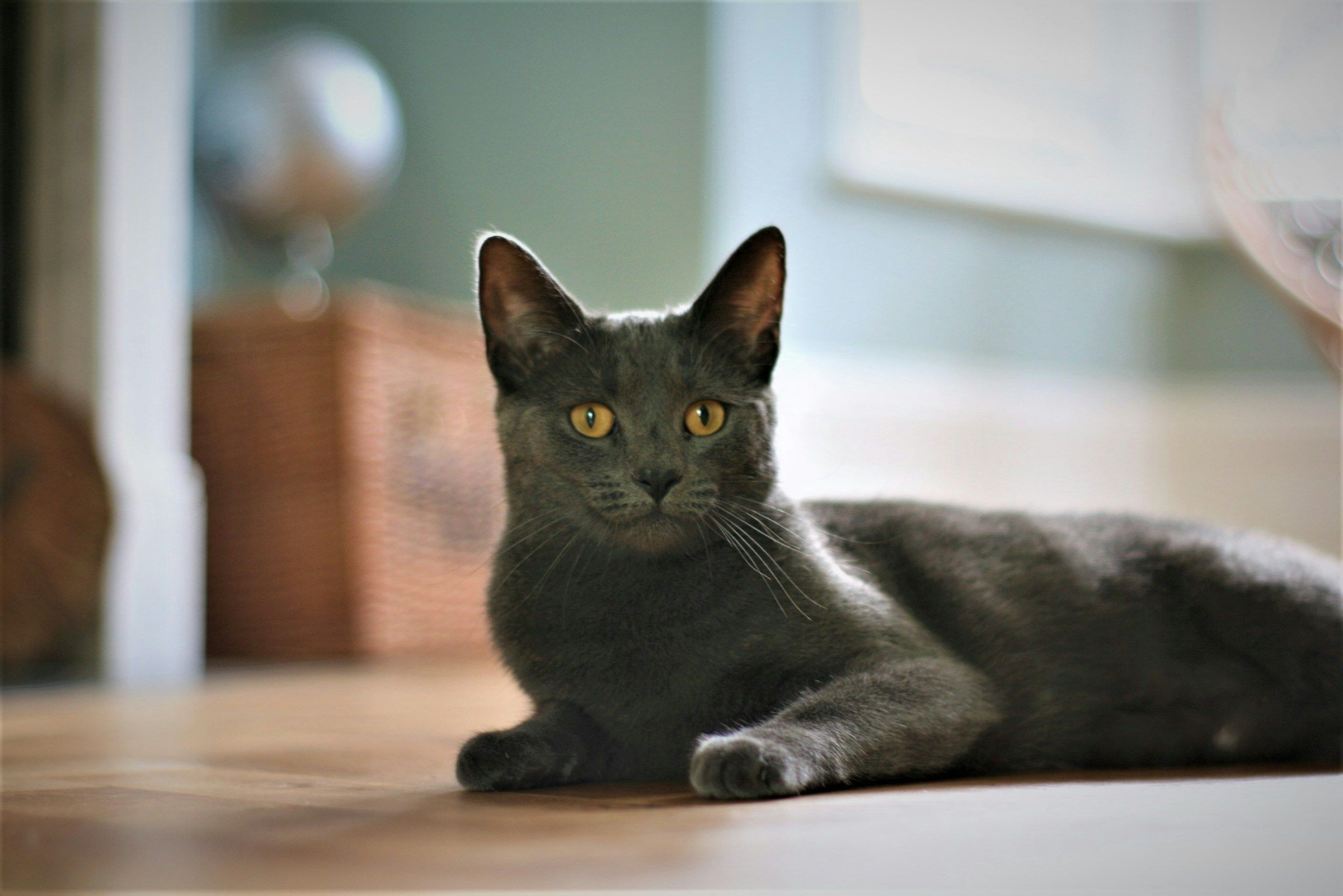 Korat Cat
Korat Cat
Credits: Paul Bryan / Unsplash – A regal Korat cat showcasing its silver-tipped blue coat and intense green eyes, sitting on a wooden surface.
Personality and Temperament: Korats are known for their intelligent, sensitive, and affectionate nature. They form strong bonds with their families and are known to be very loyal and devoted companions. They are intuitive cats, often seeming to sense their owner’s moods. While loving, they can be demanding of attention and may not do well when left alone for long periods. They are also known for their playful and active nature.
Care and Grooming: The Korat’s short, single-layer coat is very low-maintenance. Weekly brushing is usually sufficient to keep their coat in excellent condition. They are clean cats and require minimal grooming.
Health Considerations: Korats are generally a healthy breed with a long lifespan. However, they can be prone to gangliosidosis, a rare genetic neurological disorder. Responsible breeders screen for this condition.
Scottish Fold: The Grey Cat with Charming Folded Ears
The Scottish Fold is instantly recognizable for its unique folded ears, which give them an endearing, owl-like appearance. This breed originated from a barn cat named Susie in Scotland. The folded ears are a result of a natural genetic mutation affecting cartilage. While they can come in various colors, grey Scottish Folds are particularly charming, highlighting their distinctive features.
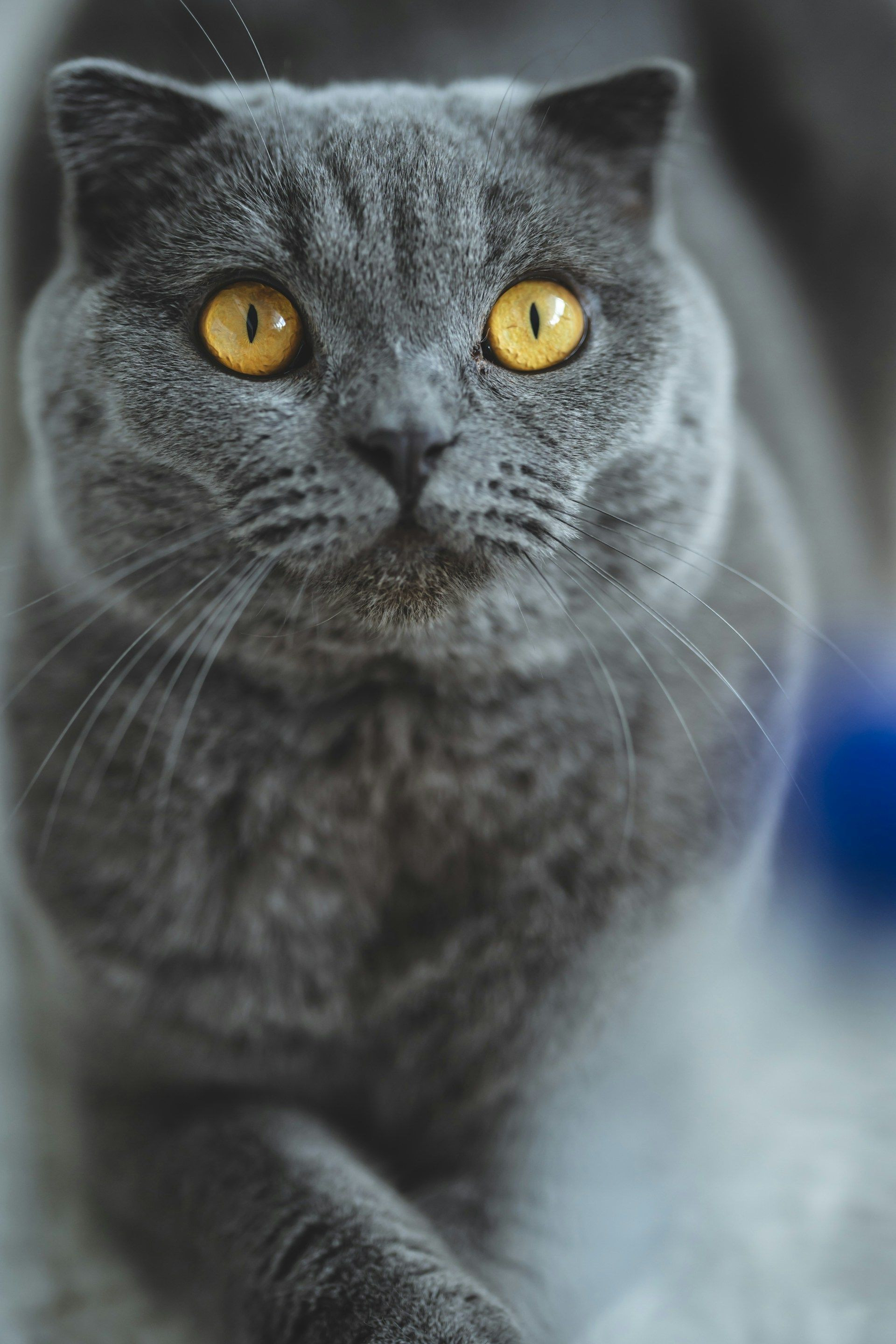 Scottish Fold Cat
Scottish Fold Cat
Credits: Omar Ram / Unsplash – A Scottish Fold cat with distinctive folded ears and grey fur, looking directly at the viewer with an inquisitive expression.
Personality and Temperament: Scottish Folds are known for their sweet, gentle, and adaptable personalities. They are calm and affectionate, enjoying human companionship and playtime. They are known to be good with children and other pets, making them excellent family cats. They are moderately active and enjoy playing with toys and exploring their environment. Scottish Folds are also known for their distinctive “sitting up” posture, resembling a Buddha or otter.
Care and Grooming: Scottish Folds can have either short or long coats, both requiring regular grooming. Weekly brushing is typically sufficient, but longhaired varieties may need more frequent attention. Special attention should be paid to their ears; they need to be cleaned regularly to prevent infections due to reduced air circulation.
Health Considerations: The gene that causes the folded ears in Scottish Folds can also lead to osteochondrodysplasia, a degenerative joint disease. This condition can cause arthritis, especially in the tail, ankles, and knees. Not all Scottish Folds will develop severe symptoms, but it’s a significant health concern for the breed. Responsible breeders are careful in their breeding programs, and potential owners should be aware of this risk.
Maine Coon: The Gentle Grey Giant of the Cat World
The Maine Coon, known as “America’s gentle giant,” is one of the largest domestic cat breeds. Originating from Maine, USA, they are characterized by their large size, shaggy coat, bushy tail, and tufted ears and paws. While they come in various colors and patterns, grey or “blue” Maine Coons are striking and accentuate their impressive size and wild appearance.
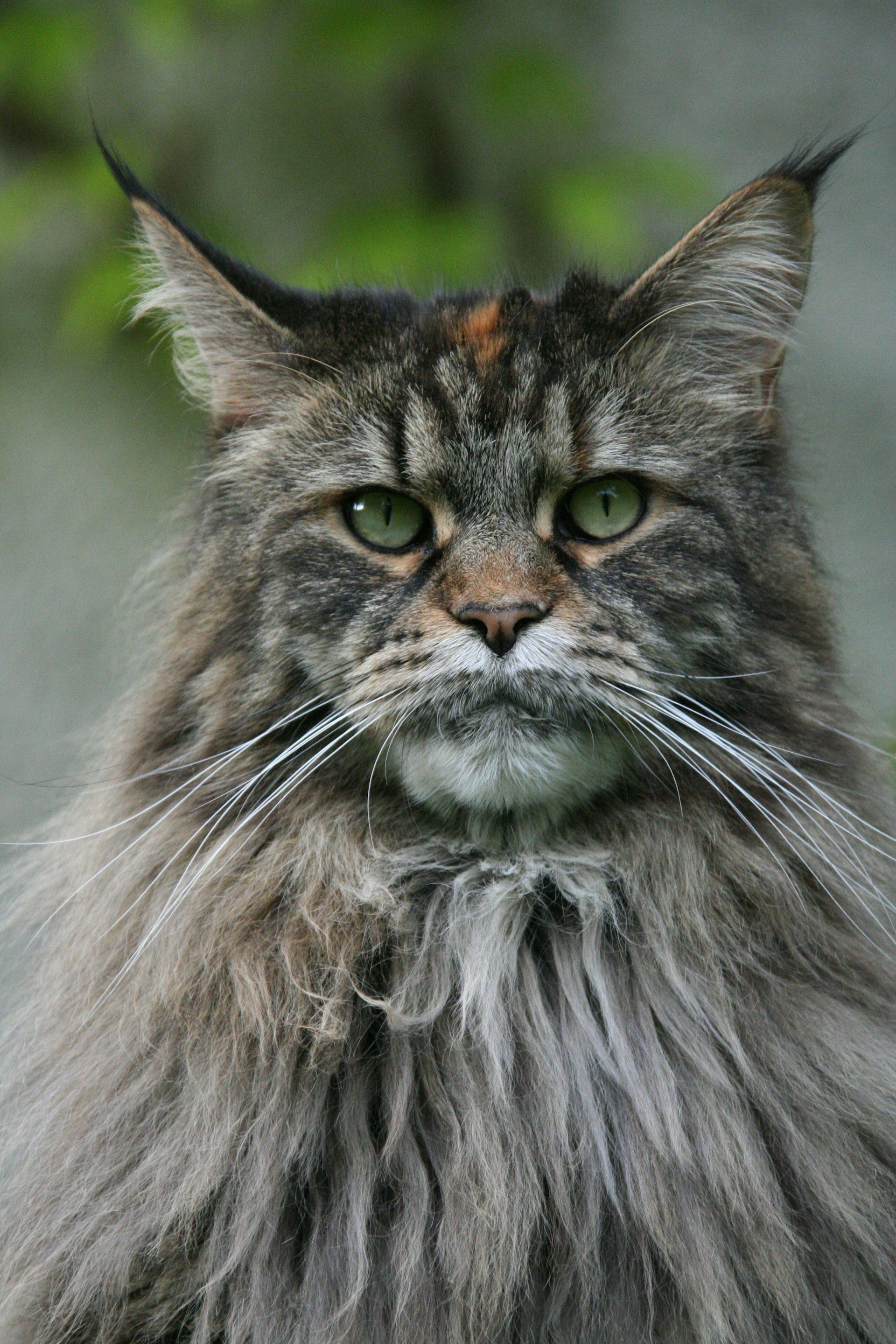 Maine Coon Cat
Maine Coon Cat
Credits: Bee Felten-Leidel / Unsplash – A large Maine Coon cat with a fluffy grey coat, majestic in appearance, captured in a natural outdoor setting.
Personality and Temperament: Despite their large size, Maine Coons are known for their gentle and friendly nature. They are playful, intelligent, and get along well with children and other pets, earning their “gentle giant” nickname. They are often described as dog-like in their behavior, sometimes following their owners around and enjoying playing fetch. They are moderately active and enjoy having space to roam and play.
Care and Grooming: The Maine Coon’s long, thick, water-repellent coat requires regular grooming to prevent mats and tangles. Weekly brushing is essential, and more frequent brushing may be needed during shedding seasons. They are relatively adaptable to grooming if started young.
Health Considerations: Maine Coons are generally a hardy breed but can be prone to certain genetic health issues, including hypertrophic cardiomyopathy (HCM) and hip dysplasia. Spinal muscular atrophy (SMA) is another condition seen in the breed. Responsible breeders screen for these conditions.
Persian: The Luxurious Long-Haired Grey Beauty
The Persian cat is synonymous with luxury and elegance, renowned for its long, flowing coat, sweet, pansy-like face, and calm demeanor. While Persians come in many colors, grey Persians, particularly blue and silver varieties, showcase the breed’s luxurious coat and gentle features beautifully.
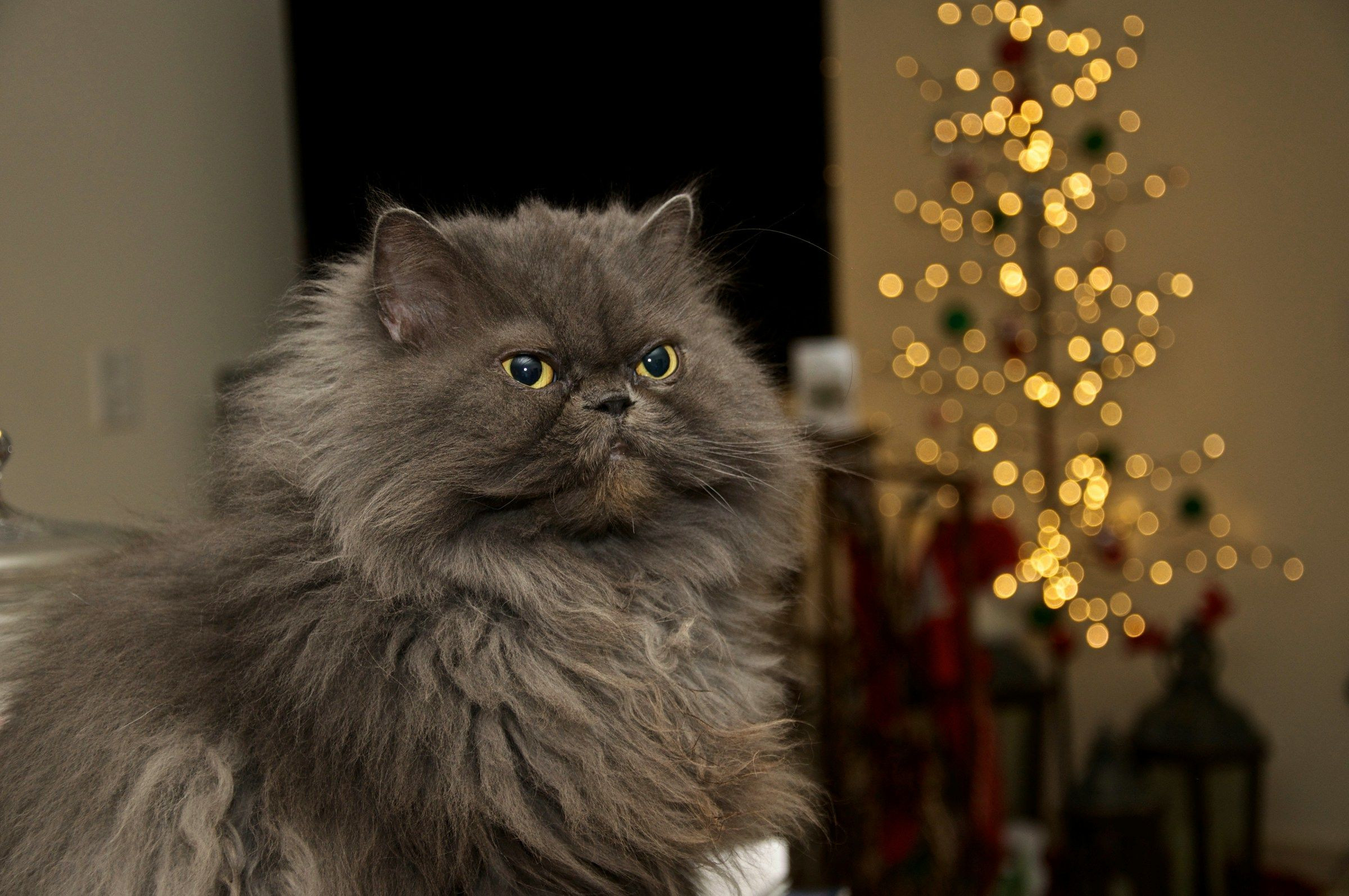 Gray Persian Cat
Gray Persian Cat
Credits: Dan Dennis / Unsplash – A Persian cat with a long, flowing grey coat, showcasing its serene expression and luxurious fur.
Personality and Temperament: Persians are known for their gentle, quiet, and affectionate nature. They are lap cats at heart, enjoying cuddling and being pampered. They are not overly active and prefer calm, predictable environments. They are generally good with children and other pets who are gentle and respectful.
Care and Grooming: The Persian’s magnificent long coat requires daily grooming to prevent matting and tangles. Daily brushing and combing are essential, and regular bathing is often necessary. Their flat faces can also predispose them to tear staining, requiring daily cleaning around the eyes. Persians are high-maintenance in terms of grooming but reward their owners with their beauty and affectionate companionship.
Health Considerations: Persians can be prone to several health issues, including polycystic kidney disease (PKD), progressive retinal atrophy (PRA), hypertrophic cardiomyopathy (HCM), and brachycephalic airway syndrome due to their flat faces. Responsible breeders screen for PKD and PRA. Potential owners should be prepared for potential health concerns and the associated veterinary care.
Egyptian Mau: The Naturally Spotted Grey Speedster
The Egyptian Mau is a rare and ancient breed, believed to be descended from cats revered in ancient Egypt. They are one of the few naturally spotted domestic cat breeds. While they come in silver, bronze, and smoke (a charcoal grey), the silver Egyptian Mau showcases striking black spots against a silvery grey background, highlighting their athletic build and wild appearance.
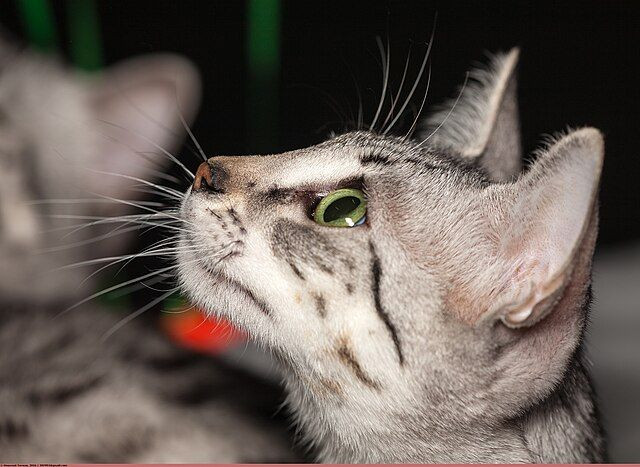 Egyptian Mau Cat
Egyptian Mau Cat
Credits: Nickolas Titkov / Creative Commons Attribution-Share Alike 2.0 – An Egyptian Mau cat with a spotted grey coat and bright green eyes, in an alert and poised stance.
Personality and Temperament: Egyptian Maus are known for their intelligence, athleticism, and devoted personalities. They are highly active and playful, enjoying climbing, jumping, and exploring. They are also known to be very fast runners, considered one of the fastest domestic cat breeds. Despite their energetic nature, they are deeply bonded to their families and can be quite affectionate. They often choose a favorite person and may be reserved with strangers.
Care and Grooming: The Egyptian Mau’s short, fine coat is low-maintenance. Weekly brushing is sufficient to keep their coat healthy and shiny. They are active cats and need plenty of opportunities for play and exercise.
Health Considerations: Egyptian Maus are generally a healthy breed with few known genetic predispositions. However, they can be sensitive to anesthesia. Responsible breeders are working to maintain the health and genetic diversity of this rare breed.
Siberian: The Hypoallergenic Grey Forest Cat from Russia
The Siberian cat, originating from the harsh Siberian forests of Russia, is a robust and adaptable breed known for its thick, triple coat that protects them from cold climates. While they come in various colors, grey Siberians, often in silver or blue shades, emphasize their wild, natural beauty and luxurious coat. They are also known for being relatively hypoallergenic, producing less Fel d 1 protein, a common cat allergen.
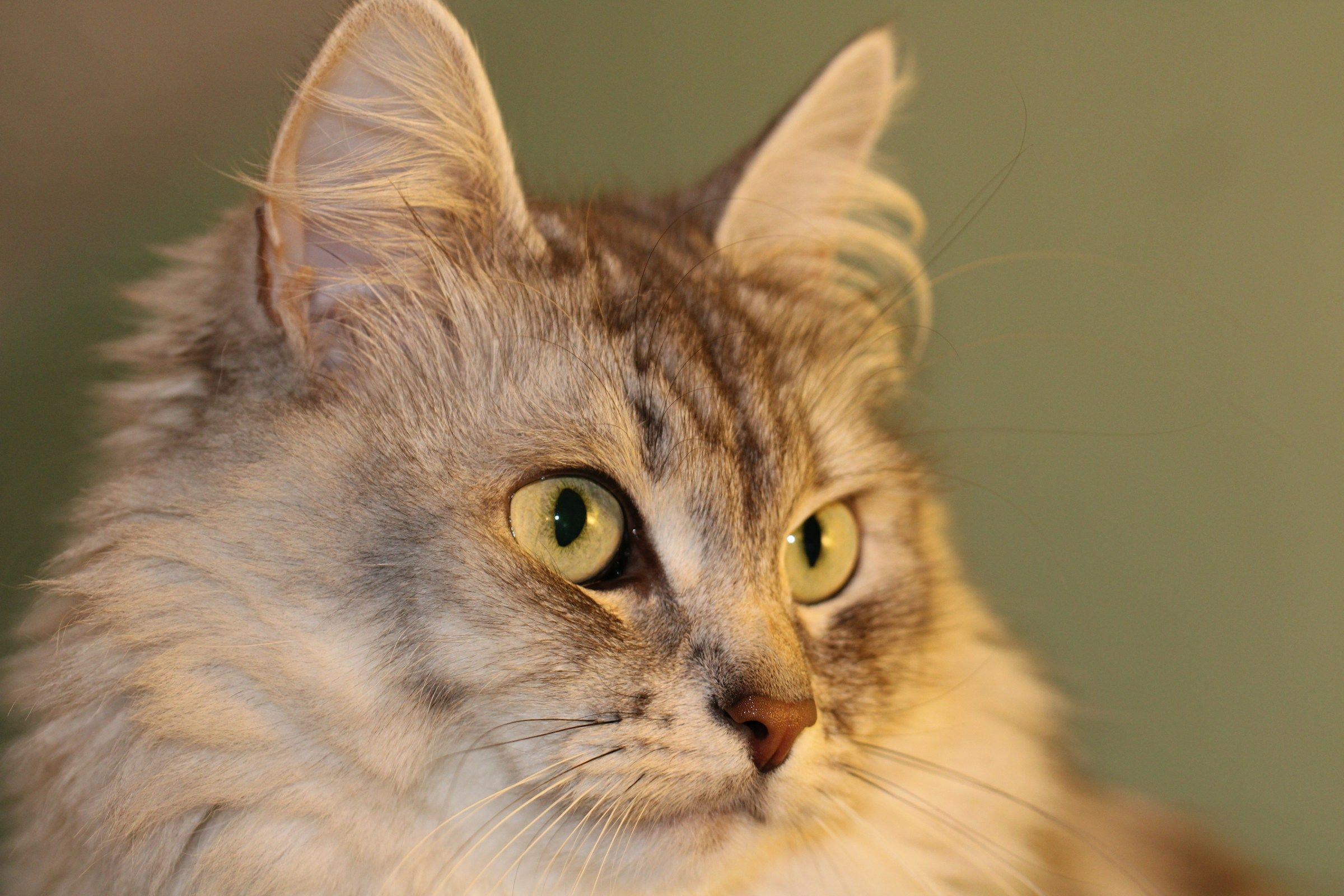 Siberian Cat
Siberian Cat
Credits: Inna Kupchenko / Unsplash – A Siberian cat with a lush grey triple coat, showcasing its robust build and long, semi-long fur.
Personality and Temperament: Siberians are known for their gentle, playful, and affectionate nature. They are intelligent and curious, enjoying interactive play and puzzle toys. They are also known to be good with children and other pets, making them excellent family companions. Despite their size and thick coat, they are surprisingly agile and graceful. They are moderately active and enjoy climbing and exploring.
Care and Grooming: The Siberian’s thick, triple coat requires regular grooming, especially during shedding seasons. Weekly brushing is essential to prevent mats and tangles, and more frequent brushing is needed during spring and fall. Despite their long coat, they are relatively easy to groom compared to Persians, as their coat is less prone to matting.
Health Considerations: Siberians are generally a healthy and hardy breed. Hypertrophic cardiomyopathy (HCM) has been reported in the breed, but it is not as prevalent as in some other breeds. Polycystic kidney disease (PKD) is also a potential concern. Responsible breeders screen for HCM.
Turkish Angora: The Graceful and Energetic Grey Beauty from Ankara
The Turkish Angora is a naturally occurring breed from Ankara, Turkey, known for its elegant appearance, silky coat, and graceful movements. While traditionally known for their white coats, Turkish Angoras also come in various colors, including grey, silver, and blue cream, showcasing their refined features and lively personality.
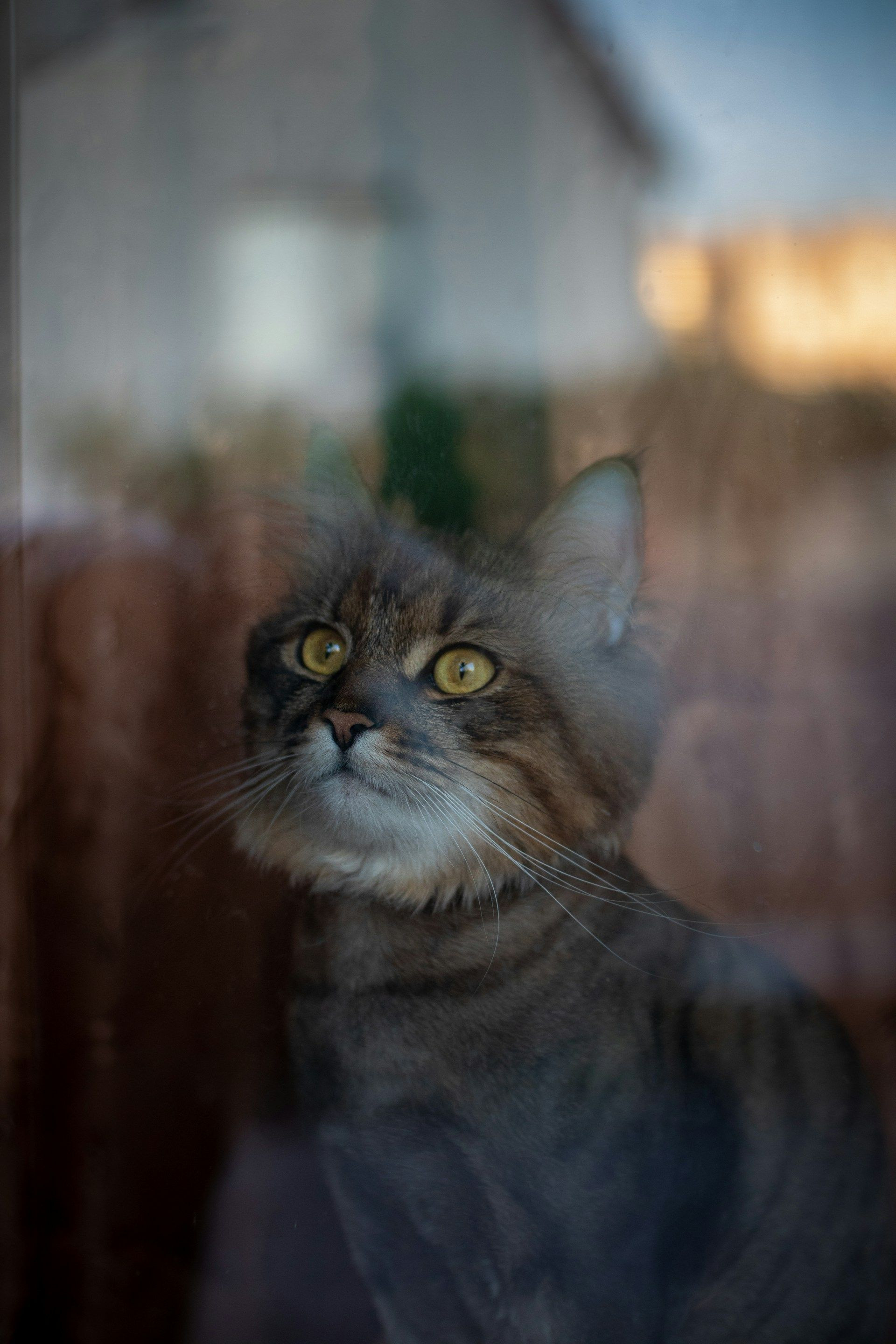 Turkish Angora cat
Turkish Angora cat
Credits: Max Shturma / Unsplash – A Turkish Angora cat with a silky grey and white coat, displaying its elegant posture and alert expression.
Personality and Temperament: Turkish Angoras are known for their intelligent, playful, and affectionate personalities. They are energetic and curious, enjoying interactive play and exploring their surroundings. They are also known to be very social and bond strongly with their families, often following their owners around and participating in household activities. They can be vocal and communicative.
Care and Grooming: The Turkish Angora’s silky, semi-long coat is relatively easy to care for compared to some long-haired breeds. Weekly brushing is usually sufficient to keep their coat in good condition and prevent mats. They are active cats and need plenty of opportunities for play and exercise.
Health Considerations: Turkish Angoras are generally a healthy breed. Hypertrophic cardiomyopathy (HCM) and hereditary ataxia, a neurological condition, have been reported in the breed, although they are not widespread. White Turkish Angoras with blue eyes can be prone to deafness, similar to other white cats.
How to Choose Your Perfect Grey Cat Companion
Choosing the right grey cat breed for you involves considering your lifestyle, home environment, and personal preferences. Each breed has its unique traits in terms of personality, activity level, grooming needs, and potential health considerations.
Consider Your Lifestyle: Are you looking for a quiet companion to relax with, or a playful and active cat to engage with? Breeds like Russian Blues and Persians are generally calmer, while breeds like Maine Coons, Siberians, and Turkish Angoras are more active and playful.
Grooming Commitment: Long-haired breeds like Persians and Maine Coons require significant grooming, while short-haired breeds like Russian Blues and Korats are lower maintenance. Assess how much time you can dedicate to grooming.
Household Dynamics: If you have children or other pets, consider breeds known for being good with families, such as Maine Coons, British Shorthairs, and Siberians.
Allergies: If allergies are a concern, the Siberian breed is known for being relatively hypoallergenic, though no cat is completely allergen-free.
Breeders and Shelters: Research reputable breeders if you are set on a specific breed, or consider adopting a grey cat from a local animal shelter or rescue organization. Shelters often have grey cats of various breeds and mixes waiting for loving homes.
Ultimately, spending time with cats of different breeds or mixes, learning about their temperaments, and considering your ability to meet their needs will help you choose the perfect grey feline companion to enrich your life. Remember that each cat is an individual, and personality can vary even within breeds. The most important thing is to offer a loving and forever home to your new grey friend.
Written by
[ PetSafe® Guest
PetSafe® Guest
PetSafe® Guest
Guest Authors
PetSafe® Expert](/blog/author/petsafe-guest/)

